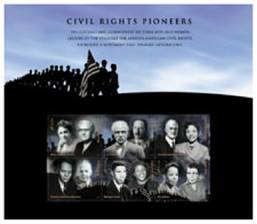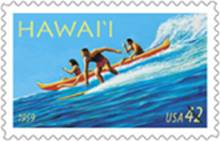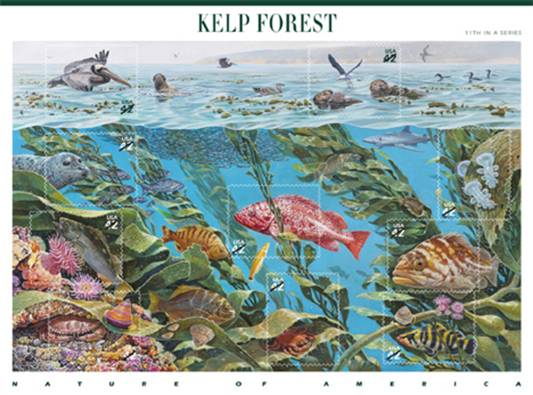Postal Service Previews 2009 Commemorative Stamp Program
To obtain high-resolution images of these stamps for media use only, e-mail mark.r.saunders@usps.gov
WASHINGTON —What do Lassie, The Tonight Show, Abe Lincoln, Gary Cooper, Gulf Coast Lighthouses, Civil Rights Pioneers and Wedding Cakes have in common? They’re all 2009 stamp subjects the U.S. Postal Service is providing a sneak peek at today. All stamp issuance dates and dedication locations are subject to change. The public is welcome to attend unless otherwise noted.
Alaska Statehood

The stamp features a photograph by Jeff Schultz of a dogsledder taken in 2000 near Rainy Pass in the Alaska Range. Text on the stamp reads “1959 ALASKA.”
Celebrating Lunar New Year: Year of the Ox

Art director Ethel Kessler of Bethesda, MD, worked on the new series with illustrator Kam Mak, an artist who grew up in New York City’s Chinatown and now lives in Brooklyn and is an associate professor in the Illustration Department at FIT. Kessler and Mak decided to focus on some of the common ways the Lunar New Year Holiday is celebrated. To commemorate the Year of the Ox, they chose a lion head of a type often worn at parades and other festivities. Dancers wear such heads, often made of papier-mâché and bamboo, as they perform for delighted crowds. “Being a Chinese American and having celebrated Lunar New Year all his life,” Kessler says, “Kam is uniquely able to show how this holiday is observed in America.” The illustration was originally created using oil paints on a fiberboard panel.
Kessler’s design also incorporates elements from the previous series of Lunar New Year stamps, using Clarence Lee’s intricate paper-cut design of an ox and the Chinese character — drawn in grass-style calligraphy by Lau Bun — for “ox.”
Oregon Statehood

Artist Gregory Manchess, of Beaverton, OR, was inspired by his own experiences along the Pacific coast to create the painting for the stamp. The result is an evocative piece that incorporates several elements of the coastline — trees, rocks, cliffs, and pounding surf — without illustrating a specific place.
“I wanted to make it an icon, an impression, of what the shoreline feels like when you look at the stamp,” says the artist. The public is invited to attend the 11 a.m. stamp dedication ceremony at the World Forestry Center’s Miller Hall, 4033 S.W. Canyon Rd., in Portland.
Edgar Allan Poe

The stamp portrait of Edgar Allan Poe is by award-winning artist Michael J. Deas of New Orleans, whose research over the years has made him well acquainted with Poe’s appearance. In 1989, Deas published The Portraits and Daguerreotypes of Edgar Allan Poe, a comprehensive collection of images featuring authentic likenesses as well as derivative portraits.
The dedication ceremony will take place at 11 a.m. on Jan. 16, at the Library of Virginia in Richmond at 800 E. Broad St.
Abraham Lincoln
The 200th anniversary of Abraham Lincoln’s (1809-1865) birth will be recognized on four commemorative stamps Feb. 9, in Springfield, IL. The 10 a.m. dedication ceremony takes place at the Old State Capitol Historic Site, Representative Hall, #1 Old State Capitol Plaza, in Springfield.
The stamp art was created by Mark Summers, who is noted for his scratchboard technique, a style distinguished by a dense network of lines etched with exquisite precision. Each stamp features a different aspect of Lincoln’s life. Summers worked under the art direction of Richard Sheaff of Scottsdale, AZ.
Rail-Splitter

Lawyer

Politician


The stamp featuring Lincoln as president, includes a Nov. 8, 1863, photograph of Lincoln by Alexander Gardner, and depicts Lincoln conferring with generals Ulysses S. Grant and William T. Sherman toward the end of the Civil War. The depiction is based on “The Peacemakers” (1868), a painting by George P. A. Healy.

On Feb. 17 in Oxford, OH, the Postal Service will commemorate Miami University’s bicentennial by issuing a stamped card in the Historic Preservation series. The image on the card depicts MacCracken Hall, a residence hall located on the South Quad of Miami University’s main campus in Oxford, OH. The stamped image on the card is a computer-generated illustration of MacCracken Hall created by artist Tom Engeman.
Civil Rights Pioneers

Art director Ethel Kessler and stamp designer Greg Berger, both of Bethesda, MD, chose to approach this project through photographic montage. Pairing two pioneers in each stamp was a way of intensifying the montage effect.
Top row of stamps:

Throughout her long life as a writer, activist, and lecturer, she was a powerful advocate for racial justice and women’s rights in America and abroad.
Mary White Ovington (1865-1951)
This journalist and social worker believed passionately in racial equality and was a founder of the NAACP.

J. R. Clifford (1848-1933)
He was the first black attorney licensed in West Virginia; in two landmark cases before his state’s Supreme Court, he attacked racial discrimination in education.
Joel Elias Spingarn (1875-1939)
Because coverage of blacks in the media tended to be negative, he endowed the prestigious Spingarn Medal, awarded annually since 1915, to highlight black achievement.

He was one of the founders of the NAACP and wrote the “Call” leading to its formation.
Daisy Gatson Bates (1914-1999)
She mentored nine black students who enrolled at all-white Central High School in Little Rock, AR, in 1957. The students used her home as an organizational hub.
Bottom row of stamps:

This lawyer and educator was a main architect of the civil rights movement. He believed in using laws to better the lives of underprivileged citizens.
Walter White (1893-1955)
Blue eyes and a fair complexion enabled this leader of the NAACP to make daring undercover investigations.

He served with distinction as an official of the NAACP in Mississippi until his assassination in 1963.
Fannie Lou Hamer (1917-1977)
She was a Mississippi sharecropper who fought for black voting rights and spoke for many when she said, “I’m sick and tired of being sick and tired.”

Ella Baker (1903-1986)
Her lifetime of activism made her a skillful organizer. She encouraged women and young people to assume positions of leadership in the civil rights movement.
Ruby Hurley (1909-1980)
As a courageous and capable official with the NAACP, she did difficult, dangerous work in the South.
Love: King and Queen of Hearts

Greco and art director Derry Noyes of Washington, DC, settled on a design flowing through the stamp perforations to make a continuous pattern. The Postal Service began issuing its popular Love stamps in 1973. Over the years these stamps have featured a wide variety of designs, including heart motifs, colorful flowers, and the word “LOVE” itself
Wedding Cake

The stamp, designed by Ethel Kessler, features a photograph of a wedding cake taken by Renée Comet of Washington, DC. The photograph depicts a three-tier wedding cake topped with white flowers, their green stems and leaves a delightful contrast to the cake’s creamy white frosting.
Wedding Rings

Bob Hope

Bob Hope (1903-2003) returns to a “stamping ovation” May 29 on the USS Midway in San Diego when the Postal Service issues a stamp in his likeness on what would have been his 106th birthday. Kazuhiko Sano of Mill Valley, CA, worked under the direction of art director Derry Noyes of Washington, DC, to create the stamp image that is based on a photograph of Hope.
Hope devoted his life to making people laugh. He is most known for his unwavering commitment — from World War II through Operation Desert Storm — to supporting morale by entertaining military personnel serving overseas. He had a top rated television show on NBC, and also found success on the live stage, in radio shows and in motion pictures. He became one of the most honored and beloved performers of the 20th century.
Although Hope never officially served in the U.S. Armed Forces, he dedicated a significant part of his life to entertaining America’s men and women in uniform, starting in 1941 and continuing through the Persian Gulf War five decades later. After giving hundreds of performances overseas, he earned the nickname “G.I. Bob” and in 1997 became the first person recognized by the U.S. Congress as an “honorary veteran of the United States Armed Forces.”
Hope’s thousands of honors also included the Congressional Gold Medal and the Presidential Medal of Freedom. Among his many friends were several U.S. presidents, with whom he often played golf for charity. Bob Hope died at his home in Toluca Lake, CA, on July 27, 2003, two months after his 100th birthday.
Anna Julia Cooper (Black Heritage)

Flags of Our Nation (Set 3 of 6)

On June 12, the Postal Services begins unfurling the second of a three-year wave of its Flags of Our Nation series by issuing 10 stamp designs: Kentucky, Louisiana, Maine, Maryland, Massachusetts Mississippi, Michigan, Minnesota, Missouri and Stars and Stripes.
In addition to the flag art, each stamp design includes artwork that provides a “snapshot view” of the state or other area represented by a particular flag. In most cases, an everyday scene or activity is shown. Occasionally the view is of something less commonplace — rare wildlife, perhaps, or a stunning vista. Unlike some previous multi-stamp issuances, this series is not limited to official animals, flowers, or products, nor is it meant to showcase well-known buildings, landmarks, or monuments.
“Snapshot” art for the Stars and Stripes stamps was inspired by the opening lines of “America the Beautiful,” written by Katharine Lee Bates (1859-1929). The spring 2009 design features “amber waves of grain,” while the fall 2009 design features “purple mountain majesties.”
The multi-stamp series featuring the Stars and Stripes, 50 state flags, five territorial flags and the District of Columbia flag was launched in 2008. Ten stamps were issued last spring, followed by 10 more last fall. The process continues in alphabetical order in 2009 and 2010, for a total of 60 stamp designs. Four of the six groups of 10 include a Stars and Stripes stamp.
Hawai‘i Statehood

Gulf Coast Lighthouses

The popular lighthouse stamps series continues to shine with the issuance of Gulf Coast Lighthouses next summer. Featuring paintings by artist Howard Koslow of Toms River, NJ, the five stamps depict the lighthouses of Matagorda Island, near Port O’Connor, TX; Sabine Pass, near Sabine Pass, LA; Biloxi, in Biloxi, MS; Sand Island, near the entrance to Mobile Bay in Mobile, AL; and, Fort Jefferson (also known as Garden Key Lighthouse), nearly 70 miles west of Key West, FL, in Dry Tortugas Park.
Known as “hurricane alley,” the Gulf Coast weathers many powerful storms each year, including Hurricane Katrina, which devastated the region in 2005. In addition, the land along the coast is swampy and marshy in many places and given to erosion, making it doubly difficult for lighthouses to withstand heavy rains and winds. The five lighthouses featured on the stamps are some of the few that remain standing.

Block your calendar for Aug. 11 to attend the dedication of the Early TV Memories stamps, scheduled to take place in Los Angeles. For more than half a century, Americans have turned to television for entertainment and information. To those watching in its early days, TV offered the additional excitement of the new. Whether laughing at the first situation comedies, tingling at crime dramas, or identifying with ordinary people who had their day in the spotlight on game shows, audiences were charmed by the novelty of the young medium. Today, memories from television’s “childhood” — often especially vivid — are a pure pleasure.
The Early TV Memories commemorated in the 20 stamp set include: Adventures of Ozzie & Harriet; Alfred Hitchcock Presents; Dinah Shore Show; Dragnet; Ed Sullivan Show; George Burns & Gracie Allen Show; Hopalong Cassidy; The Honeymooners; Howdy Doody; I Love Lucy; Kukla, Fran and Ollie; Lassie; The Lone Ranger; Perry Mason; Phil Silvers Show; The Red Skelton Show; Texaco Star Theater; Tonight Show; Twilight Zone; and, You Bet Your Life.
Richard Wright

On April 9, former Chicago Post Office employee and renowned author Richard Wright (1908-1960) becomes the 25th inductee into its Literary Arts series. The dedication ceremony will take place at 11 a.m. in the lobby of the Chicago Post Office, 433 W. Harrison St.
Best remembered for his controversial 1940 novel, Native Son, and his 1945 autobiography, Black Boy, Wright drew on a wide range of literary traditions, including protest writing and detective fiction, to craft unflinching portrayals of racism in American society.
The stamp artwork by Kadir Nelson of San Diego, CA, features a portrait of Richard Wright in front of snow-swept tenements on the South Side of Chicago, a scene that recalls the setting of Native Son. Nelson’s portrait of Wright was based on a circa 1945 photograph. Nelson worked under the direction of art director Carl T. Herrman of Carlsbad, CA.
Thanksgiving Day Parade

Four stamps featuring iconic scenes of a Thanksgiving Day Parade — a lively marching band, large balloons of favorite animals and popular characters, and crowds of delighted onlookers — begin marching out of Post Offices Sept. 9, once the stamps are dedicated that day in Macy’s in New York City.
Drawing on the long and rich visual history of Thanksgiving Day parades in the U.S., artist Paul Rogers of Pasadena, CA, collaborated with Art Director Howard E. Paine of Delaplane, VA, to base the stamp designs on American advertising and poster art from the mid 20th century. Rogers used a combination of airbrush and digital medium to create the colorful and nostalgic images featured on the stamps.

On Sept. 10, Gary Cooper (1901-1961), becomes the 15th inductee into the Legends of Hollywood series when the Postal Service honors the popular leading man from Hollywood’s “Golden Age.” For decades, Cooper was the all-American hero, whose believable performances and strong, silent appeal brought him a lifetime of fame.
Art director Phil Jordan designed the stamp using a portrait by artist Kazuhiko Sano of Mill Valley, CA. The image is based on a black-and-white photograph of Gary Cooper taken by George Hurrell circa 1940. The selvage art — or area outside of the stamps — is based on a still from High Noon (1952), depicting Cooper in his Academy Award-winning role as the courageous Marshal Will Kane.
United States Supreme Court Justices

Joseph Story ranks as one of the nation’s most influential jurists. The author of dozens of volumes of legal commentary, Story — who viewed law as a science — gave shape to American jurisprudence while also making the law more accessible to practicing attorneys. His devotion to the uniform enforcement of federal regulations by all the states helped establish the preeminence of the Supreme Court.
Louis D. Brandeis was the associate justice most responsible for helping the Supreme Court shape the tools it needed to interpret the Constitution in light of the sociological and economic conditions of the 20th century. “If we would guide by the light of reason,” he once exhorted his colleagues, “we must let our minds be bold.” A progressive and champion of reform, Brandeis devoted his life to social justice. He defended the right of every citizen to speak freely, and his groundbreaking conception of the right to privacy continues to impact legal thought today.
Felix Frankfurter was arguably one of the most enigmatic and controversial figures ever to sit on the Supreme Court. As the Court’s strongest proponent of judicial restraint, Frankfurter — who served 23 years as an associate justice — believed that judges should disregard their own social views when making decisions. “History teaches,” he wrote, “that the independence of the judiciary is jeopardized when courts become embroiled in the passions of the day.”
William J. Brennan, Jr., the author of numerous landmark decisions and the inspiration behind many others, believed that law is an essential force for social and political change. Brennan — the Court’s most determined opponent of the death penalty — championed equal rights for all citizens and steadfastly regarded the Constitution as a living document that should be interpreted to fit modern life. “The genius of the Constitution,” he declared, “rests not in any static meaning in a world that is dead and gone, but in the adaptability of its great principles to cope with current problems and current needs.”

To celebrate October as National Stamp Collecting Month the Postal Service issues the 11th stamp pane in an educational series focusing on the beauty and complexity of major U.S. plant and animal communities.
The 2009 Nature of America: Kelp Forest stamps will be dedicated at the Monterey Aquarium in Monterey, CA. The stamp pane features a kelp forest off the central California coast on the front. The back of the pane identifies 27 of the creatures from the front.
A kelp forest is a remarkable undersea ecosystem dominated by very large marine algae more commonly known as seaweeds or kelp. To illustrate the biodiversity of a kelp forest, artist John D. Dawson of Hilo, HI, depicted more than 27 different species in his colorful acrylic painting. The scene itself is imaginary and a dense grouping of creatures was necessary to illustrate as many species as possible on the stamp pane. Even so, all of the species could be encountered at or near the Monterey Bay National Marine Sanctuary, the area featured on the pane. All of the species and their interactions are appropriate and were recommended by scientists. Dawson worked under the art direction of Ethel Kessler.
Christmas: Madonna and Sleeping Child by Sassoferrato

The painting depicted on the stamp shows a blond Madonna clothed in red and cradling the sleeping Christ Child in purple cloth. From each of the two top corners, the childlike face of a cherub looks down from the clouds.
Winter Holidays

A merry reindeer dangles a red bulb ornament from his antler. Flurries of large flakes dust a snowman sporting a top hat, coal buttons and a carrot nose. A gingerbread man is decorated for the season, with green, red, and white icing. A toy soldier smiles while standing at attention. Borders of evergreens, stars, wreaths, and holly add another holiday touch to the stamps.
Stamp artist Joseph Cudd, of Greensboro, NC, created the stamps under the direction of Richard Sheaff.
Angel with Lute

The musical angel on this stamp was originally part of a larger fresco depicting the ascension of Christ in the apse of the Basilica dei Santi Apostoli (Church of the Holy Apostles) in Rome. The complete fresco included Christ, the Apostles, and several angelic musicians. It was painted around 1480 but destroyed in 1711 when the church was reconstructed.
Although few of Melozzo’s works have survived, art historians have praised his skilled use of perspective, and he is sometimes considered one of the great fresco artists of his day. In recent years, his depictions of musical angels have enjoyed a newfound popularity.
Hanukkah (menorah)

Spanning eight days and nights, Hanukkah is a joyous yearly festival celebrated by Jews around the world. The holiday commemorates the successful revolt of the Jews led by Judah Maccabee against the oppressive government of Antiochus IV and the Seleucid Empire in 165 B.C.E.
Hanukkah is the Hebrew word for "dedication." Tradition relates how a miracle took place during the rededication of the Temple in Jerusalem, which had been desecrated. The remaining supply of sacramental oil, thought to be enough for only one day, burned for eight days.
The eight days and nights of Hanukkah begin on the 25th of Kislev in the Hebrew calendar, a date that falls in late November or December. Hanukkah begins on Dec. 11 in 2009, and on Dec. 1 in 2010.
During Hanukkah, family members gather each night during the festival to light candles on a special candleholder. Other Hanukkah traditions include singing, the exchange of gifts, and the spinning of the dreidel, a four-sided top. Children typically use chocolate gelt (coins) to make bets on the outcome of each spin of the dreidel.
Kwanzaa (family)

The bold colors in the stamp art are complemented in the top right corner by the colors of the Kwanzaa flag — green for growth, red for blood, and black for the African people — which are the same colors as the Pan-African flag. The field of green around the borders symbolizes growth and a bountiful harvest. In the hoop that the girl holds in her hands, as well as in the family grouping of mother, father, and child, McNeill symbolized unity.
This is the third stamp design issued by the Postal Service in celebration of Kwanzaa. The first Kwanzaa commemorative stamp was issued in 1997. McNeill worked under the direction of Art Director Carl T. Herrman.
# # #
Please Note: For broadcast quality video and audio, photo stills and other media resources, visit the USPS Newsroom at www.usps.com/communications/newsroom/welcome.htm.

